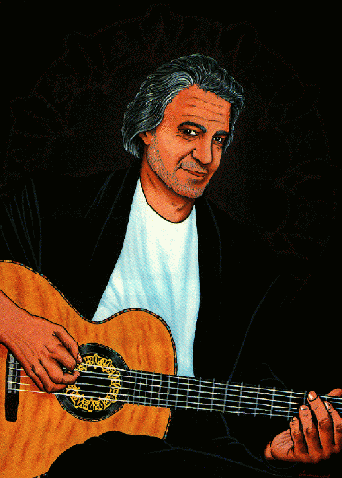JOHN McLAUGHLIN
by Matt Resnicoff
(reprinted from Guitar Player magazine: May 1994)

Illustration by Isabelle Samaras
"The music, of course, is poetry."
Did John McLaughlin, that seldom earthbound improviser and devout
spiritualist, throw out his back while wrenching his body skyward in a fit
of inspiration? Not quite. John had to suffer through the recent Tokyo
recording of his next album because weeks earlier, he'd leapt on his dog to
prevent it from fighting with another dog on the beach. John overcame, he
survived, he thrived. He overcame two years earlier, after he severed the
tip of his left index finger on a television pivot. He overcame the death
of fusion, the birth of happy-jazz, deaf record executives, Jan Hammer.
John McLaughlin shrinks at no challenge, however ugly.
But none of this explains why he didn't play in the States even once in
1993, when acoustic pop and jazz enjoyed new heights of visibility. He
didn't need to: Europe keeps him plenty busy, and some of his past acoustic
work, especially 1980's Trio smash Friday Night in San Francisco with Al
Di Meola and Paco de Lucia, and Live At The Royal Festival Hall featuring
Indian percussionist Trilok Gurtu, have charted higher than anyone might
have imagined for "jazz" records. Certainly McLaughlin's been at no loss
for acoustic profile, and since the late 60's -- when he began
investigating the regional musics that culminated in the group Shakti and
found him alongside everyone from Miles Davis to Egberto Gismonti -- his
rapturous relationship with the acoustic guitar has made up the bulk of his
work, and arguably some of his best. But as John reaches wide, he also
reaches back into his past, so that even when the contexts shifts from hard
rock to the alap to the "Mediterranean" concerto with full orchestra, his
voice remains distinct. He is no less blinding on, say, Time Remembered,
doing interpretations of plaintive Bill Evans pieces with a classical
guitar quartet, than he was while flailing with the Mahavishnu Orchestra.
Nothing can stop him, nothing can corner him. "You guys are really far
behind!" he laughs while considering his acoustic career; he's spent the
past nine months playing a Bigsby-equipped Gibson Johnny Smith with Free
Spirits, a band deploying powerhouse drummer Dennis Chambers and organ
prodigy Joey DeFrancesco. "I was really sick when I made the record," he
says, "but there's some good music on there." Apparently, understatement is
an acoustic musician's secret weapon.
|